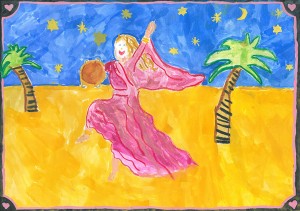They betray the hopes, dreams, and projections of fathers and mothers,they follow trends, and foretell the future of their bearers.
For Jews many decisions are connected to the naming of a child: should the name underscore his religious affiliation, only be recognizable to other Jews, or neither? Will it be a name native to the family’s country of origin or to the child’s country of birth? Has the name been translated? Does it memorialize someone? Colleagues and friends of the Jewish Museum Berlin share their thoughts with this blog, on this and other questions.
Miriam / Mirjam
Soon there will be four women working along the hallway that my office is on, who all have the same first name that I have: Mirjam or, in some cases, Miriam. Even while the etymology is not completely unambiguous, the triumphant prophetess with the timbrel is namesake to each of us – that Miriam who roused the women to dance a dance of joy after the Israelites had fled from Egypt and divided the Red Sea (2. Moses 14, 20). With that, the sister of Moses and Aron took her rightful place among scripture’s female figures – women like both of the wives of the first man Adam, Lillith and Eve – who showed their rebellious traits: Miriam asserted the claim that God also spoke through her. She was consequently struck with a skin rash and had to wait for seven days outside of the encampment before she was allowed to live among the congregation of her desert-crossing brethren (4. Moses 12, 1-16).
Is it an accident that this combative woman lent her name to so many employees of the Jewish Museum Berlin? → continue reading


